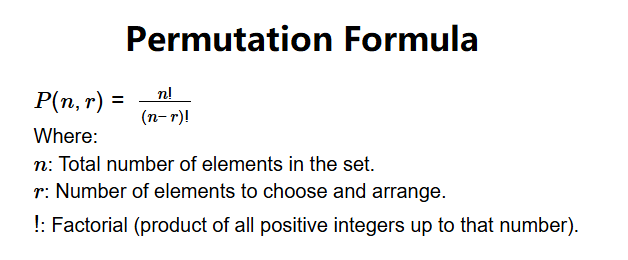1. What is a Permutation Calculator?
Definition: This calculator computes the number of ways to arrange \( r \) elements from a set of \( n \) elements, where the order matters.
Purpose: It aids in combinatorial problems, probability calculations, and scenarios like arranging cards or scheduling tasks.
2. How Does the Calculator Work?
The calculator uses the formula:
- \( P(n, r) = \frac{n!}{(n - r)!} \)
- Where:
- \( n \): Total number of elements in the set.
- \( r \): Number of elements to choose and arrange.
- \( ! \): Factorial (product of all positive integers up to that number).
Steps:
- Input \( n \) (total elements) and \( r \) (elements to choose).
- Validate: \( n \geq 0 \), \( 0 \leq r \leq n \), all integers.
- Compute \( P(n, r) = \frac{n!}{(n - r)!} \) using factorials.
- Display the result with scientific notation if > 100,000 or < 0.0001, otherwise as an integer.
3. Importance of Permutation Calculations
These calculations are crucial for:
- Combinatorics: Solving arrangement problems.
- Probability: Determining the likelihood of specific sequences.
- Computer Science: Algorithm design and permutations in sorting.
4. Using the Calculator
Examples:
- n = 9, r = 3:
- \( P(9, 3) = \frac{9!}{(9 - 3)!} = \frac{362880}{720} = 504 \).
- Result: 504.
- n = 10, r = 5:
- \( P(10, 5) = \frac{10!}{(10 - 5)!} = \frac{3628800}{120} = 30240 \).
- Result: 30240.
- n = 20, r = 10:
- \( P(20, 10) = \frac{20!}{10!} \approx 6.70442572 \times 10^{10} \).
- Result: 6.70e10 (scientific notation due to > 100,000).
5. Frequently Asked Questions (FAQ)
Q: Why use scientific notation?
A: For large permutations (e.g., \( 10^{10} \)), it improves readability.
Q: What if \( r > n \)?
A: The calculation is invalid, and an error is displayed.
Q: What is \( P(n, n) \)?
A: It equals \( n! \), the number of ways to arrange all elements.
 Home
Home
 Back
Back
